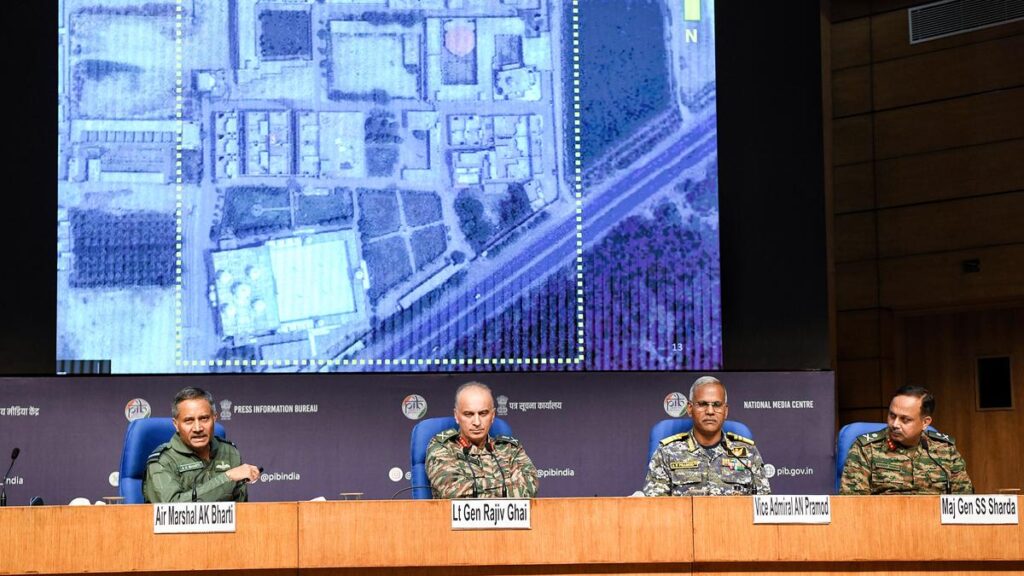
(Left to Right) Air Marshal A.K. Bharti, DGMO Lieutenant General Rajiv Ghai, Vice Admiral A.N. Pramod and Major General S.S. Sharda during a press conference on Operation Sindoor, in New Delhi on May 11, 2025.
| Photo Credit: ANI
India has achieved the desired objectives of Operation Sindoor, which is “still ongoing”, and Pakistan will have to pay a very heavy price if it resorts to any misadventure, said Director-General Military Operations (DGMO) Lt.-General Rajiv Ghai on Sunday (May 11, 2025).
The warning by the armed forces came as an “understanding” between the two countries to stop firing and other military activities, in force since 5 p.m. on Saturday, held precariously amid several ceasefire violations (CFVs) and drone intrusions.
Indian Army chief General Upendra Dwivedi reviewed the security situation with Army Commanders of the western borders. The DGMO said the Army chief had “granted full authority to the Commanders for counter-action in the kinetic domain in case of any violation by Pakistan”.
India Pakistan ceasefire: Follow LIVE updates on May 11, 2025
“We have thus far exercised immense restraint and our actions have been focused, measured and non-escalatory. However, any threat to the sovereignty, territorial integrity and safety of our citizens will be met with decisive force,” Lt.-General Ghai said at a tri-service briefing on Sunday. He said over 100 terrorists, including high-value targets such as Yusuf Azhar, Abdul Malik Rauf and Mudasir Ahmed, who were involved in the hijacking of Indian Airlines flight IC-814 in 1999 and the 2019 Pulwama attack, were eliminated during Operation Sindoor on May 7 while 35 to 40 Pakistani military personnel were killed in combat on the Line of Control (LoC) in the escalation that followed.
Recounting the sequence of events leading to the “understanding” between the two militaries, Lt.-General Ghai said a message was received from Pakistan’s DGMO on the hotline on May 10 seeking clarity on his willingness to communicate. “Since our initial aim was to strike terror camps and all our actions in the subsequent days were in response to the intrusions and violations by the Pakistan Air Force and Pakistan Army, it was decided that I would indeed speak with the Pakistani DGMO,” he said.
The DGMOs spoke at 3.35 p.m. on Saturday and it resulted in cessation of cross-border firing and air intrusions by either side from 5 p.m. “We also decided to speak further on May 12 [Monday] at 12 p.m. to discuss the modalities that would enable the longevity of this understanding,” he stated.

He noted that it took only a couple of hours for the Pakistan Army to violate these arrangements, followed by drone intrusions across the expanse of the western front from Saturday night to the early hours of Sunday, he said. “These violations were responded to robustly and dealt with as they must be,” the officer said, adding that a hotline message was sent highlighting their violation and India’s “firm and clear intent to respond to these fiercely and punitively, if repeated tonight or later.”
The senior officers of the three services observed that it was the massive retaliatory attack by India, which targeted several Pakistani air bases on Saturday morning that prompted Pakistan to reach out for the understanding.
The nights of May 7, 8, and 9, besides the morning of May 10, saw massive strikes by Pakistan using drones, missiles and Unmanned Combat Aerial Vehicles (UCAVs) targeting civilian and military locations across the western border. India’s air defences had shot down most of the incoming threats while Indian armed forces also launched counter-strikes on military installations in Pakistan.
On the Navy’s role, Vice-Admiral A.N. Pramod, Director-General Naval Operations (DGNO), said in the aftermath of the Pahalgam terror attack on April 22, the “Carrier Battle Group, surface forces, submarines and aviation assets were immediately deployed at sea with full combat readiness, in concert with the joint operational plan” of the Indian defence forces.

“The forward deployment of the Indian Navy compelled Pakistani naval and air units to be in a defensive posture, mostly inside harbours or very close to their coast, which we monitored continuously,” the DGNO said, adding that they maintained seamless Maritime Domain Awareness throughout and were entirely aware of the location and movement of Pakistani units.
Military and government officials stated that Operation Sindoor is “still ongoing” as the operational alert continues. Sources in the know said that since the launch of Operation Sindoor, the message of “If you hit, we hit and if you stop, we stop” has been very clear. “With every round of military exchange, things grew worse for Pakistan and on May 10, Indian armed forces devastated eight Pakistani military bases after which they reached out offering to stop firing,” they said.
Published – May 11, 2025 11:42 pm IST
Source:https://www.thehindu.com/news/national/we-inflicted-heavy-losses-on-pakistan-military-india/article69565006.ece

